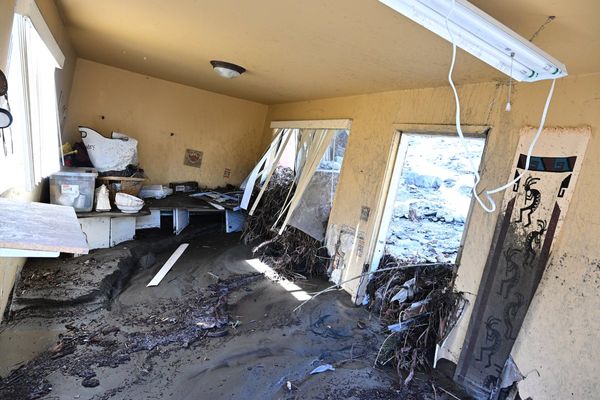
There aren’t many jobs in which a cartwheel can make or break your dreams. But at the Moulin Rouge in Paris, the ability to do the move with confidence and grace means everything. “A girl can be a great dancer, but if you can do a cartwheel on your left side and not your right? You won’t get the job,” Fanny Rabasse, the venue’s press manager, tells me. After all, there’s a high, 134-year-old standard to uphold.
Since 1889, the Moulin Rouge has been a landmark of Parisian live entertainment, famed for its high-kicking can-can line, luxurious costumes, topless female dancers and, of course, the red windmill that gave it its name. Thanks to Baz Luhrmann’s 2001 film, the Pigalle venue was immortalised in the imaginations of a younger, international audience, with fans indulging in the lavish romance of Nicole Kidman’s courtesan, Satine, and Ewan McGregor’s poor poet, Christian.
But that Oscar winner, and its stage musical adaptation, are mere works of fiction. Now, a new documentary series aims to show the realities of life at the Moulin: pheasant feathers, personal gripes and performance anxieties to boot. BBC Two’s Moulin Rouge: Yes We Can-Can! tracks the day-to-day of the people who make the show come to life: namely, the performers delivering the high-energy routines. Yorkshire-born Janet Pharaoh is one of the major figures in the series. Formerly a dancer on the Moulin Rouge stage, Pharaoh became the company’s ballet mistress and artistic director in the late 1990s. She’s in charge of who gets selected for the troupe. A third of her recruits are fellow Brits, with others coming from as far afield as Australia to join the company.
When I meet Pharaoh under the glow of hundreds of red lamps in the theatre, her devotion to the production is clear. As the first of Friday night’s two performances get underway, she is watching intently, despite having seen the show on countless occasions. “I’m seeing something new, every time,” she says, admitting that she has few qualms with letting a dancer know about a missed step or lacklustre turn.
But Pharaoh isn’t just scrutinising her dancers’ movements. “Unless you know how to put eyelashes on, don’t put them on,” she says in one of the episodes, admonishing an unlucky auditionee. Despite a move towards body diversity in other areas of the entertainment industry, the Moulin Rouge has an unwavering commitment to prioritising slim, statuesque women, and tall, muscular men. For female dancers, long, slightly disproportionate legs are preferred, in order to make the can-can appear that much more spectacular. “Their breasts need to be well-formed, high, not drop and not too big,” Pharaoh states matter-of-factly in the documentary. “A figure that looks good in the G-strings.”
Some would consider women dancing topless as an outdated feature for a 2020s audience. I’ll admit, I’m a little shocked when they appear. But the surprise soon wears off, and the dozens of bared nipples simply become an aspect of the glittering costumes. “It’s part of beauty: same as the legs, bums, hands, face, hair… boobies,” says Pharaoh on-camera, with a shrug. Press manager Rabasse has a similar response to questions of whether it’s still appropriate for bare breasts to feature in the production, and waves any criticisms away as people being “woke”. For her, it’s a matter of choice. “People say, ‘How can you have topless dancers in 2023?’ But they are proud to do it,” she tells me.
Topless dancers heading to the Moulin Rouge stage— (BBC/Dragonfly)
From the costume makers painstakingly fixing rhinestones back onto damaged outfits, to the backstage assistants quickly dressing the performers in between routines, it is intoxicating how much everyone at the Moulin Rouge relishes their part in it. In her 11 years dancing on the stage, Dublin-born Claudine Van Den Berghe Cooke knows all there is to know about the show, working her way from the chorus line to being a principal performer with solo routines. And despite performing the same show twice a night, six nights a week, the dancer is still motivated, and reviews footage of her performances. “I still move positions a bit, jumping into other spots and filling other roles when it’s needed,” she tells me. “I love doing that, because it teaches me about my own spot, and the ways that I need to move. It keeps my brain working.”
Janet Pharaoh backstage with the costumes— (BBC/Dragonfly/Philip Wojazer/Moulin Rouge)
For many professional dancers, reaching the hallowed halls of the Moulin Rouge is the dream job. But as the documentary shows, even the sweetest of dreams must come to an end. A principal dancer called Jess – nicknamed “Tooney” – resigns from her role after 12 years, ready to head back to Stratford-upon-Avon for a new career in real estate. Eleven years in, Van Den Berghe Cooke is also looking ahead to what the future will bring, and tells me of her part-time law studies in the hopes of becoming a lawyer. Since our meeting, she’s left the company to pursue law completely, leaving her younger sister Isabelle behind at the venue to carry on the family name.
Standing up in court will surely be a breeze after more than a decade of dancing on the Moulin Rouge stage for 600,000 visitors each year. The show I see on my visit is Féerie, which has literally run on repeat since 1999. It’s dazzling, with the dancers leaping, writhing and twirling, often in unison. The company takes pride in the fact that Féerie has remained unchanged for 24 years, save for the relatively recent removal of a Russian act, in light of the war in Ukraine. But its devotion to tradition is a hindrance elsewhere; some vignettes are set in locations such as Egypt and South Asia, and their majority white company’s performances feel jarring. Still, the closing routine of the French can-can, retaining the same steps since its 19th-century origins, makes a rousing finale that leaves the crowd swept up in its magic.
Dancers performing the can-can at the Moulin Rouge— (BBC/Dragonfly)
With the lush dinner-theatre setting, its sultry lighting and an open dancefloor ahead of the show, a night at the Moulin Rouge is an experience that you can only truly grasp from within its plush walls. But until that’s possible, a series that goes deeper into its legend than ever before is the next best thing.
‘Moulin Rouge: Yes We Can-Can!’ starts on BBC Two at 10pm on Wednesday 27 September







